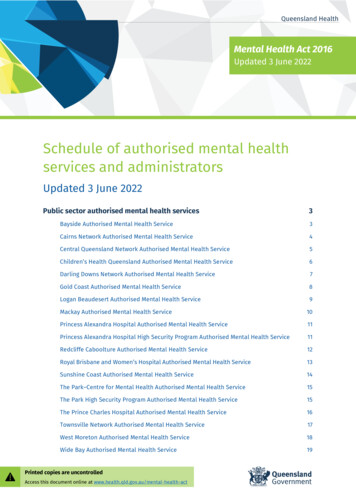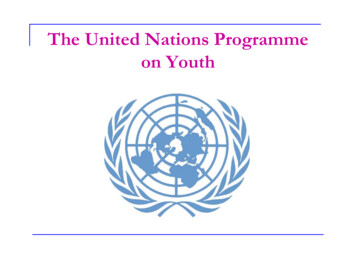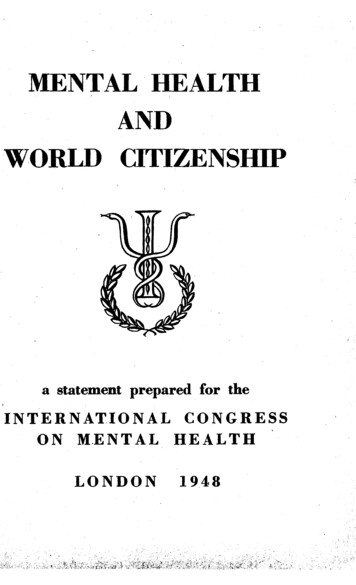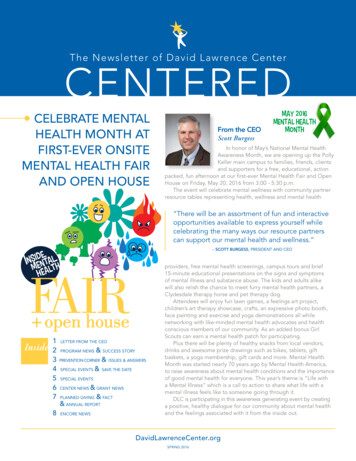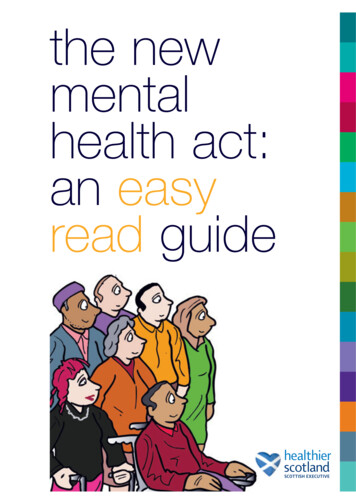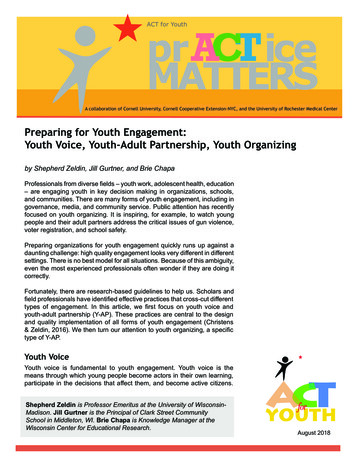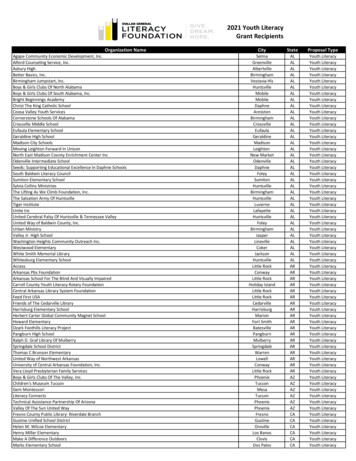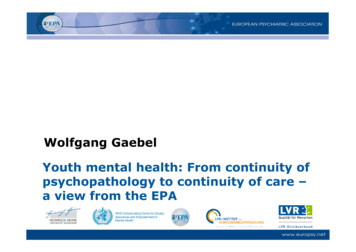
Transcription
Wolfgang GaebelYouth mental health: From continuity ofpsychopathology to continuity of care –a view from the EPA
EPA – Some FactsEuropean Psychiatric AssociationMission: Improving the quality of mental health careacross EuropeBoardExecutive Committee (EC)(19 members)(5 members)Chaired by the President of the EPACouncil of National PsychiatricAssociations (NPAs)“Council” of individual members( 2.400 members from 90 countries)(37 European NPAs from 32 countries)Representing over 80.000 European psychiatristsEPA Committees (e.g., guidance)20 EPA Sections (e.g., child/adolescence psychiatry, suicidology,psychopathology, epidemiology, prevention - collaborating withNPAs’ Sections)
From Childhood to Adult Psychopathology: A Complex PathwayTurecki G, Nat Rev Neurosci 1014: published online Oct 30, 2014. doi:10.1038/nrn3839
Onset of Psychiatric DisordersImpulse-controldisorderSubstance usedisorderAnxiety disorderMood disorderSchizophreniaYears of Age 510152025303540Adapted from Kessler et al., 2005n. Kessler et al., 2005
Example Schizophrenia: Evolution of Symptoms Over TimeEarly detectionand treatment canimprove adultmental healthFusar-Poli et al. 2013 JAMA Psychiatry / Arch Gen Psych 2013;70:107-120
Mediators of Continuities and Discontinuitiesin Developing Psychopathology Genetic liabilities (recurrence is more likely if “familialloading” is present, but may act via environmentalintermediates) Kindling effects (experience of a mental disorder bringsabout changes that make re-occurence more likely) Psychopathology increases the likelihood of exposure torisk environments in adult life Adverse experiences in childhood influence the likelihoodof the occurrence of mental disorders Individual response patterns influence risk (e.g.,reliance on drugs or alcohol) People s concepts of mental disorders influence thedisease course (e.g., attributional biases)Rutter et al., Journal of Child Psychology and Psychiatry 2006;47:276–295
The International Declaration of Youth Mental Health** International Association of Youth Mental Health
From Childhood to Adolescent and Adult Mental HealthcareCritical period for interventions to managethe transition phaseChildhood/AdolescentPsychiatric ServicesAge [years]Adult Psychiatric Services18?Transition Phase ( 15-21 ?)
Mental Healthcare Pathways at the Transition Stage The transition rate of those in need is about 60%Patton et al., Lancet 2014; 383: 404-411 The reasons for non-transition are manifold and includeamong others: Unclear psychopathologyLack of need of transitionRefusal by patient or parentPerceived lack of competence of adult psychiatric servicesImprisonmentCriteria for adult mental healthservice use not fulfilled“No show” (lack of attendance of adult referral site)Singh et al., Br J Psychiatr 2010; 197: 305-312
Mental Healthcare Pathways at the Transition Stage:Examples
Mental Healthcare Pathways at the Transition Stage:Target-Group Specific InformationParentsPatientsProfessionals
The International Declaration of Youth Mental Health
The International Declaration of Youth Mental Health
Practice Example: The Heidelberg ModelJoint Child & Adolescence Adult Mental Healthcare ServicePatients12-25 yearsmainlyschizophrenia andaffectivedisordersPsychiatric Ward (16 beds)jointly operated byChild and Adolescence Psychiatristsand Adult PsychiatristDay PatientTreatmentModuleOutpatientTreatment Module(assertive mentalhealthcareservice)Resch F, Weisbrod M. Kooperative Versorgung Jugendlicher und junger Erwachsener. In: Fegert JM et al.,Psychiatrie und Psychotherapie des Kindes- und Jugendalters. Heidelberg: Springer Verlag, 2012
Youth Mental Health: From Continuity of Psychopathologyto Continuity of Care – 5 Challenges as Viewed by EPA1. Avoid adverse biopsychosocial events during childhood2. Improve early recognition and early treatment3. Provide continuous care across the adolescent/adult agetransition stage4. Develop, implement and evaluate innovative integratedchild/adolescent/adult mental healthcare services5. Promote further research into the factors and mechanismspromoting progression of childhood/adolescent mental andbehavioural disorder into adult mental disorders
Elements Constituting an Optimized Transition ProtocolSingh et al., BJP 2010, 197:305-312
Tasks for EPA and NPAs Set topic on the European and National health policy agendas Provide cross-national level data about the mental health caresituation at the transition phase in each country, models of care,experiences and challenges Establish collaboration with the respective European and Nationalchild/adolescent psychiatry societies to evaluate the situation ineach country Develop, implement and evaluate innovative mental health carepathways spanning the transition phase with joint responsibilityof child/adolescent and adult psychiatrists and consumers (a topic forEPA Guidance) Raise awareness and fight against the stigma of mental illnessand the responsible mental healthcare services in the youth/adolescent age Encourage the use of mental healthcare services by providingspecifically tailored information about the available services toyoungsters, patients, parents and mental health care professionals
Youth Mental Health Transition:5 Features of Guidance Recommendations as Viewed by EPA1. Guidance Recommendations need to be concrete, practical andfeasible2. Recommendations should be evidence- and consensus-based(evaluate the existing evidence-base, apply systematic procedures forconsensus, grade recommendations)3. Guidance should be developed and endorsed including representatives of professional associations, stakeholders andconsumers from the respective countries (e.g., relevant agegroups of patients, family representatives)4. Structure-, process- and outcome-recommendations should bedeveloped on the macro-, meso- and micro-level of youth mentalhealth care but need to be adapted to the requirements of specificEuropean countries5. Implementation should be monitored and evaluated by adequate(mental) health outcome and service indicators embedded intoquality management procedures including regular updates
Summary and Conclusions There is a continuity of psychopathology betweenchildhood/adolescence mental disorders and adult mental disorders in60% of childhood/adolescent cases of mental disorders Psychopathology evolves over the years Early detection and treatment of mental disorders will improveadult mental health Mental healthcare at the transition achieves continuity in onlyapproximately 60% of adolescence cases of mental disorders The unmet need of transition may be addressed by developingstructured transition programmes involving childhood & adolescencepsychiatrists, adult psychiatrists, patients and parents EPA may provide a platform for developing evidence-basedguidance for the transition phase
Thank you for your attention!
EPA Conference Patronage EPA has granted patronage to the event This entails non-financial support Use of EPA logo “Organised unter the patronage of EPA” Event was promoted on the EPA website
Structure (II)20 Sections Addictive BehavioursChild and AdolescentPsychiatryConsultation LiaisonPsychiatry & PsychosomaticsCultural PsychiatryEmergency PsychiatryEpidemiology and SocialPsychiatryForensic PsychiatryGeriatric PsychiatryMental Health and IntellectualDisabilities (MHID)NeuroimagingYouth mental health transition Philosophy and PsychiatryPrevention of ychotherapySchizophreniaSexual Medicine and MentalHealthSuicidology and SuicidePreventionTeleMental HealthWomen, Gender and MentalHealth
European Psychiatric Association (EPA) – StatutesThe purpose and main aim of the EPA is to improve the quality ofmental healthcare throughout Europe, by (inter alia): Enhancing the standard of psychiatric education and training;Promoting excellence in psychiatric research and clinical practice;Supporting the development of public health policies relevant to MH;Disseminating information about psychiatric research and practice;Contributing to initiatives improving ethical standards of psychiatriccare;Encouraging professional interchange/exchange between EuropeanPsychiatrists;Representing European psychiatry in the framework of the variousEuropean InstitutionsProviding a unified organisation European Psychiatric Association, Statutes Version utes/Youth mental health transition
Resch F, Weisbrod M. Kooperative Versorgung Jugendlicher und junger Erwachsener. In: Fegert JM et al., Psychiatrie und Psychotherapie des Kindes-und Jugendalters. Heidelberg: Springer Verlag, 2012 Joint Child & Adolescence Adult Mental Healthcare Service Psychiatric Ward (16 beds) jointly operated by Child and Adolescence Psychiatrists

